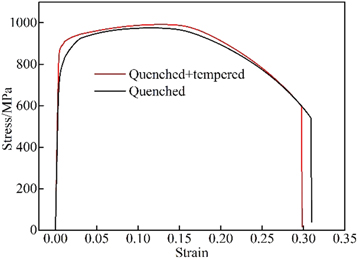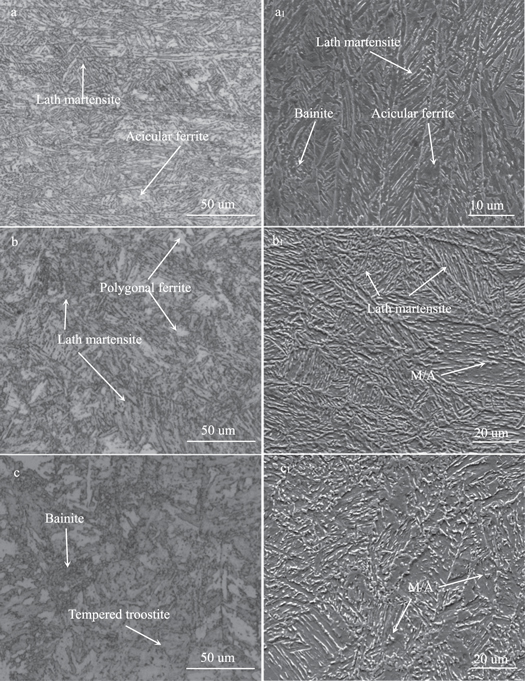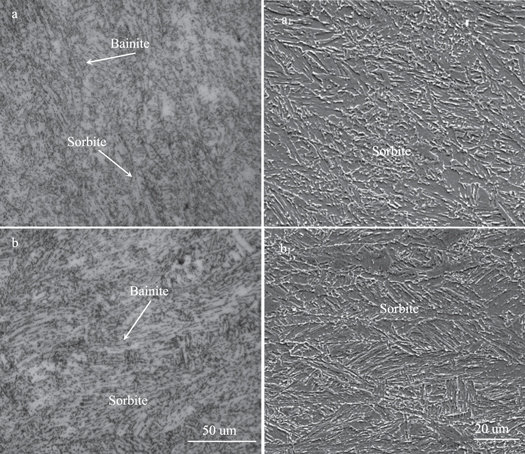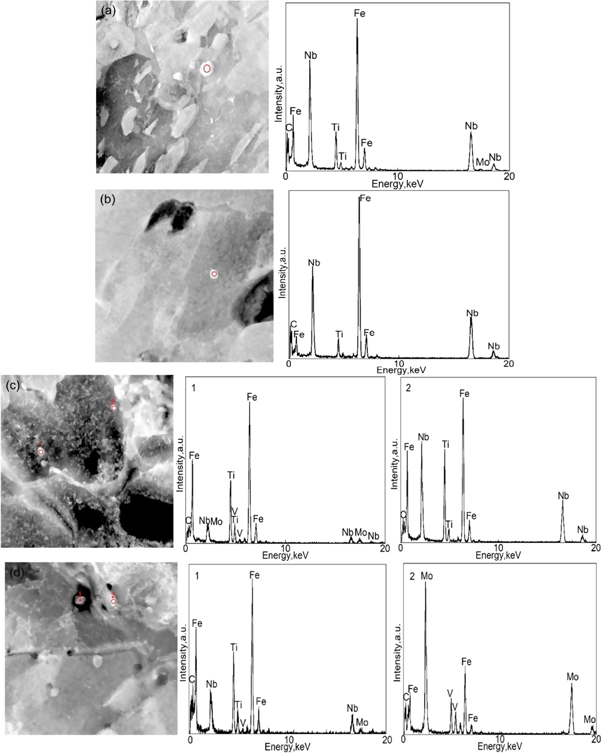Abstract
In this precent study, microstructure evolution of a newly developed 690 MPa composite microalloyed anti-seismic fire-resistant steel plate after quenching at 740 °C , quenching at 740 °C + tempering at 400 °C were studied and the fire resistance mechanism was analyzed. Experimental results show that the microstructure of hot rolled state of the tested steel is lath martensite, acicular ferrite, bainite and M/A island. After quenching at 740 °C, the microstructure of steel was composed of lath martensite, polygonal ferrite and retained austenite. The mixed microstructure of tempered troostite + bainite + a small amount of M/A island was obtained after quenching at 740 °C + tempering at 400 °C , it transforms into tempered sorbite + bainite after holding at 600 °C for 3h. A great number of fine carbides containing Mo, Nb, V and Ti precipitate at 600 °C of the quenched + tempered state of tested steel. The mixed microstructure and fine composite carbides make the quenched +tempered steel have excellent fire resistance.
Export citation and abstract BibTeX RIS

Original content from this work may be used under the terms of the Creative Commons Attribution 4.0 licence. Any further distribution of this work must maintain attribution to the author(s) and the title of the work, journal citation and DOI.
1. Introduction
The high-rise and complex development of buildings put forward higher requirements on fire resistance and earthquake resistance of steel, while the yield strength of plain steel decreases rapidly in case of fire, making it necessary to develop fire-resistant building steel [1–3]. Fire-resistant steel is in a normal C-Mn steel with Mo, Nb, Ti, V alloying elements. It is required that the yield strength should not be less than 2/3 of room temperature yield strength after holding at 600 °C for 1–3 h, so as to enhance the fire resistance of buildings, improve safety, and provide sufficient time for personnel escape and property transfer [4, 5], and have a good seismic resistance, ductility, weldability, corrosion resistance and so on.
The mechanical properties of steels are mainly affected by the microstructure[6]. However, the microstructure is mainly affected by the composition and heat treatment process. Many researchers [7, 8] have studied the effects of heat treatment on the microstructure and mechanical properties of steel materials. Pandey.C. [9, 10] found that the normalizing and tempering of the aged sample are quite helpful in regaining the mechanical properties and microstructural feature. In view of different types of fire resistance steel manufactured from different heat-treatment processes, their mechanical behaviours under fire would be different [11]. Many researchers [12–14] uesd heat treatment to improve fire resistance by controlling precipitation behavior and microstructure structure at high temperature. Ma [15] found that hot rolled microstructure of Q460 FRW fire-resistance steel mainly consists of granular bainite and acicular ferrite. After heat preservation at 600 °C, M/A component gradually decompose, acicular ferrite transforms into massive ferrite, and the precipitate contains MX (M = Nb, Ti. X = C, N). At present, researches on fire-resistance steels mainly focus on the influence of composition design [16, 17] and heat treatment [18–21] on microstructure and mechanical properties of low yield strength fire-resistance steels. But the law of microstructure evolution and mechanical properties change is not clear and there has been no research on effects of heat treatment on the fire resistance of 690 MPa grade fire-resistance steel.
Thermo Calc. thermodynamic calculation software was used to calculate the end temperature of austenitic transformation in the cooling process of steel is 678 °C, and combined with previous experience [22, 23] set the quenching and tempering temperature as 740 °C and 400 °C, respectively. The evolution process of microstructure and precipitation mechanism of a kind of new 690 MPa composite microalloyed anti-seismic fire-resistant steel plate was studied by 740 °C quenching and 740 °C quenching + 400 °C tempering. Aims to provide reference for the actual production process.
2. Experimental materials and methods
Steel ingot of 150 mm thickness were smelted by 100 Kg vacuum induction furnace, and then rolled into 20 mm thick plate. The steel rolled by two processes, The initial and final rolling temperature are 1080 and 1020, respectively. Secondary rolling is carried out at 850 °C, and the finishing temperature is 800 °C, water cooling. Table 1 is the chemical composition (mass fraction, %) of experimental fire-resistant steel. The heat treatment process is shown in table 2.
Table 1. Chemical composition of test steel (wt%).
| C | Si | Mn | Ni | Cu | Ti | Nb | V | Cr | Mo |
|---|---|---|---|---|---|---|---|---|---|
| 0.08 | 0.27 | 1.40 | 0.35 | 1.0 | 0.02 | 0.08 | 0.06 | / | 0.56 |
Table 2. Heat treatment process parameters.
| States | Processing parameters |
|---|---|
| Hot-rolled state | Hot rolling |
| Quenched state | Quenching at 740 °C for 60 min |
| Quenched + tempered state | Quenching at 740 °C for 60 min, Tempering at 400 °C for 60 min |
The mechanical properties of the tested steel plate were analyzed by tensile tests at room temperature and 600 °C, and the specimen dimensions of tensile and toughness show in figure 1. The microstructure was observed by AXIOVERT40 MAX optical microscope (OM) and TESCAN VEGA3 scanning electron microscopy (SEM). Extraction replica samples and thin sheet samples were prepared, and the microstructure, composition, morphology, size and distribution of precipitates were observed and analyzed by Tecnai G3 TF30 S-Twin transmission electron microscope (TEM). A 500 um thin sheet sample was cut and thinned to about 60 um by mechanical thinning, and a φ3 mm was made, and then thinned by electro polisher in 6% perchloric acid alcohol solution (volume fraction) (30 V constant pressure −15 °C) to prepare the thin sheet sample.
Figure 1. The tensile specimen dimension ((a): room temperature, (b): 600 °C) and toughness specimen dimension(c).
Download figure:
Standard image High-resolution image3. Experimental result
3.1. Mechanical properties
The properties requirements of 690 MPa high yield strength anti-seismic fire-resistant steel plate are as follows: yield strength ratio ≤0.85, elongation rate after fracture ≥18%, yield strength not less than 460 MPa after holding at 600 °C for 1–3h. Figure 3 is the stress-strain curve for the tensile tested specimen at room temperature, and table 3 shows the test results of mechanical properties at room temperature. Comparing the mechanical property data of the tested steel at different state in figure 2 and table 3, it can be seen that hot-rolled state of the steel have high yield strength and tensile strength at room temperature, reaching 940 MPa and 1200 MPa respectively, and the yield strength ratio is 0.78, but elongation rate and reduction of area are low, 14.8% and 18% respectively. The yield strength of the quenched state is 767 MPa, which is lower than that of the hot-rolled state, but elongation rate and the reduction of area is increased to 19.7% and 24% respectively, the comprehensive mechanical properties are improved. After quenching at 740 °C and tempering at 400 °C, the yield strength is increased by 55 MPa compared with sample B and the elongation is 28%.
Table 3. Mechanical properties at room temperature.
| States | Yield strength/MPa | Tensile strength/MPa | Yield strength ratio | Elongation % | Reduction of area % |
|---|---|---|---|---|---|
| Hot-rolled state | 940 | 1200 | 0.78 | 14.8 | 18 |
| Quenched state | 767 | 971 | 0.79 | 19.7 | 24 |
| Quenched + tempered state | 822 | 990 | 0.83 | 20.6 | 28 |
Figure 2. Stress-strain curve for the tensile tested steel after heat treatment at room temperature.
Download figure:
Standard image High-resolution imageTable 4 shows the performance of heat treated steel at 600 °C. The results show that the elongation of quenched state of tested steel is more than 30% at 600 °C, but its yield strength is less than 460 MPa, which does not meet the high temperature property requirements of the fire-resistant steel plate. Yield strength of quenched + tempered state of the tested steel at high temperature is 475 MPa, and is higher than that of quenched state, that's more than 2/3 of 690 MPa, and the yield strength ratio is 0.80. Therefore, the tested steel plate after quenching at 740 °C+tempering at 400 °C has better high temperature seismic resistance properties, higher elongation and excellent fire resistance.
Table 4. Mechanical properties at 600 °C.
| States | Yield strength/MPa | Tensile strength/MPa | Yield strength ratio | Elongation % | Reduction of area % |
|---|---|---|---|---|---|
| Quenched state | 458 | 561 | 0.82 | 30.3 | 42 |
| Quenched + tempered state | 475 | 589 | 0.80 | 32.1 | 49 |
3.2. Microstructure evolution
3.2.1. Microstructure at room temperature
Figure 3 shows the microstructure of different states at room temperature. Combined with OM and SEM images, it is found that the microstructure of hot-rolled state mainly consists of lath martensite, a small amount of acicular ferrites, bainites and residual austenite. This is because the cooling rate is fast during the cooling process, and the carbon atoms can not diffuse in time, so martensite and ferrite are formed. When the temperature drops to room temperature, bainite is formed by self-tempering. The microstructure of quenched state consists of lath martensite, polygonal ferrite and a small amount of residual austenite. After quenching at 740 °C and tempering at 400 °C, some of the residual austenite in M/A island is decomposed into bainite, a mixed microstructure composed of tempered troostite, bainite, ferrite and a small number of M/A islands obtained.
Figure 3. OM, SEM images of microstructure at room temperature. (a) hot-rolled state (b) quenched state (c) quenched + tempered state.
Download figure:
Standard image High-resolution imageFigure 4 shows the TEM morphology at room temperature. M/A islands can be observed in both quenched and quenched + tempered state, which is an island structure composed of residual austenite and martensite, a large number of dislocations are distributed in the ferrite, and fine particles are precipitated near the matrix and grain boundary. The carbon content in tempered troostite is less in the quenched + tempered state, which reduce the pressure on the retained austenite, so that the retained austenite is transformed into bainite, and the fine alloy carbide particles in ferrite are increased obviously.
Figure 4. TEM images of microstructure at room temperature. (a) quenched state (b) quenched + tempered state.
Download figure:
Standard image High-resolution image3.2.2. Microstructure at 600 °C high temperature
Figure 5 shows the microstructure at 600 °C, which mainly includes tempered sorbite, a small amount of granular bainite. At this temperature, lath martensite and M/A island decompose greatly, alloying elements transfer into cementite and grow up continuously, and forming tempered sorbite with polygonal ferrite matrix. It can be found that the orientation of lath martensite is also retained in quenched + tempered state of tested steel, and there are more granular bainite and M/A islands, fine cementite particles in the steel, which is beneficial to hinder the expansion of grain boundaries.
Figure 5. OM, SEM images of microstructure at 600 °C. (a) quenched state (b) quenched + tempered state.
Download figure:
Standard image High-resolution image3.3. Precipitation behavior
Figure 6 shows the TEM images and chemical composition of precipitates in different states after heat treatment. At room temperature, it is mainly composite microalloyed carbides containng Nb and Ti without Mo precipitation (figures 6(a), (b)). This is due to the high solid solubility of Mo in ferrite, which requires a high energy to precipitate. After holding at 600 °C for 3 h, a small amount of Mo and V are precipitated in addition to Nb and Ti (figures 6(c), (d)). Microalloying elements Mo, Nb, Ti and V can be precipitated compound at high temperature, the precipitation behavior of Mo and V is more obvious in quenched + tempered state of tested steel at high temperature.
Figure 6. TEM images and energy spectrum of precipitate at room temperature (a), (b) and 600 °C (c), (d). (a), (c) quenched state (b), (d) quenched + tempered state.
Download figure:
Standard image High-resolution imageFigure 7 shows observation results of microstructure replica after heat treatment. It is found that there are mainly two morphologies of square shape and ellipsoid shape. At room temperature, a few number of microalloy carbides were precipitated and dispersed in the quenched state of tested steel. A great number of microalloy carbides were precipitated after tempering at 400 °C, and some of the carbides grew and coarsened (figure 7(b)). There are a large number of composite precipitates in the two samples at 600 °C, but the number of fine particles in the quenched state is obviously less than those at room temperature (figure 7(c)), spheroidization and growth occur during the heating and holding process. However, the number of precipitates in the quenched + tempered state increases greatly than that in the room temperature (figure 7(d)), and a lot of fine particles are distributed around the large-particle precipitates.
Figure 7. Morphology and distributions of precipitates at room temperature (a), (b) and 600 °C (c), (d). (a), (c) quenched state (b), (d) quenched + tempered state.
Download figure:
Standard image High-resolution imageFigure 8. TEM images of microstructure at 600 °C (a) quenched state (b) quenched + tempered state.
Download figure:
Standard image High-resolution image4. Discussion
4.1. Effect of microstructure on fire resistance
The mechanical properties of steel are mainly affected by the microstructure and its stability. It can be seen from the previous results that heat treatment has a significant effect on the microstructure of the experimental steel. The content of Mo in the experimental steel is high, and the proeutectoid ferrite is formed first at the cooling stage of rolling. During the transformation process, alloying elements such as Mo and C diffuse into the austenite, which increases the stability of austenite. With the further decrease of temperature, carbon-rich austenite forms lath martensite, while the untransformed retained austenite and martensite form carbon-rich M/A island, which is a sub-stable component [24–26], mainly distributed near the boundary between ferrite and martensite, and a large amount of bainite is obtained. The hot rolled sample has high yield strength but poor plasticity and toughness, and the comprehensive mechanical properties can't meet the requirements of building steel.
Compared with the hot rolled steel, the yield strength decrease after 740 °C quenching, but the plasticity and toughness are improved. This is because the quenching temperature is lower than the final rolling temperature, the growth of austenite is not sufficient, which makes the lath martensite obviously refined and the ferrite size grow up, As a result, the soft phase ferrite is increased. The yield strength of mixed microstructure mainly depends on the yield strength of soft phase in matrix [26, 27]. After tempering at 400 °C, the supersaturated carbon in lath martensite precipitates to form relatively stable tempered troostite. The phase boundary of multiphase microstructure composed of tempered troostite + bainite has a good effect on preventing dislocation movement [28–30], which makes the steel plate have excellent comprehensive mechanical properties.
Most of Mo exists in matrix in the form of solid solution, and the diffusion rate of Mo is low at high temperature, which can significantly strengthen the ferrite matrix and improve high temperature yield strength of experimental steel. Figure 8 shows TEM morphology of different state of tested steel at 600 °C. Dislocation exists in ferrite and a large number of cementite particles are distributed, which form tempered sorbite. Among them, there are more fine cementite particles in quenched + tempered state, which are mainly distributed along grain boundaries, and fine M/A islands can also be observed at grain boundaries. There is a strong interaction between solute atoms, cementite particles and dislocations at high temperature. A large number of fine microalloyed precipitates, cementite particles and a small amount of M-A islands in steel strengthen the matrix, which slows down the decrease of high temperature yield strength.
The elongation of quenched state is 42% at 600 °C, but the yield strength is greatly reduced. This is because the lath martensite obtained by quenching is an unstable microstructure, and less microalloyed carbides precipitated during rapid cooling, which can't play the role of pinning grain boundary. When reheated, the supersaturated carbon in lath martensite precipitates to form tempered troostite. With the further increase of temperature, tempered sorbite is formed, M/A island decomposes, and the content of martensite is greatly reduced, which reduces the yield strength at high temperature. The results show that composite microstructure obtained by 740 °C quenching + 400 °C tempering is tempered troostite + bainite + a small amount of M/A islands, which has good stability and slow decomposition at high temperature. At the same time, the phase boundary has an inhibiting effect on the diffusion of carbon and alloying elements, which is conducive to inhibition the coarsening of ferrite and precipitates, and jointly ensures the high temperature yield strength of experimental steel [31], making the quenched + tempered state steel have excellent fire resistance.
4.2. Effect of microalloy carbides on fire resistance
The experimental results show that the samples in different states exhibit different precipitation behavior at high temperature. After holding at 600 °C, only 42.25% of the precipitates are under 60 nm in quenched state, which is less than the same particle size at room temperature (figure 9). This is because there are a lot of dislocations in the matrix, and self-tempering occurs when quenching and cooling to a low temperature, which helps solute atoms to diffuse and precipitate a large number of fine microalloy carbides [32], but these microalloy carbides coarsen with the increase of temperature. The proportion of precipitates larger than 100 nm at 600 °C is as high as 19.54%, so the precipitation strengthening effect is greatly weakened. However, the number of precipitates in quenched + tempered state increases greatly at 600 °C, the proportion of fine microalloy carbides increases by 3.17% compared with that at room temperature, indicating that the precipitated microalloy carbides formed in the quenched + tempered state are relatively stable, there are also fine microalloy carbides in ferrite and residual austenite during high temperature holding, which is conducive to the high yield strength of matrix microstructure [29]. 400 °C tempering is conducive to precipitation of Mo and V at high temperature, which is related to the fact that carbides containing Mo and V in steel has a high solid solubility product and not easy to be precipitation, and the microalloy carbides of Mo element impedes the coarsening of alloy carbides [33].
Figure 9. Length distributions of precipitates at room temperature (a), (b) and 600 °C (c), (d). (a), (c) quenched state (b), (d) quenched + tempered state.
Download figure:
Standard image High-resolution imageIn addition, although there are carbide particles precipitated in quenched state during heating, the number of precipitates is obviously less than that in quenched + tempered state (figures 7(c), (d)). This is because although there are a lot of alloying elements and vacancies in quenched state, these vacancies and solute atoms are greatly reduced during the heating process, which will affect the precipitation rate at high temperature. However, there are a large number of fine and stable alloy carbides in quenched + tempered state. These carbides do not dissolve back during heating, and can also be used as nucleation points at high temperature, so as to improve the precipitation rate [34, 35]. It can be seen that heat treatment has a significant effect on the precipitation behavior of experimental steel, and ultimately affects the size, morphology and distribution of precipitated particles.
The precipitation behavior of microalloyed carbides will further affect the mechanical properties of the experimental steel. In most cases, the size of the precipitates is larger than the critical transition size, so the strengthening mechanism is mainly Orowan mechanism, and the strengthening effect is roughly inversely proportional to the size of the precipitates, and the effect of fine precipitates on improving the strengthening is very significant [32–37]. During the heating and holding process, the yield strength of quenched state decreases rapidly, while the yield strength of quenched + tempered state is still high. This is because a large number of fine microalloyed carbides precipitated in the quenched + tempered state at high temperature have an important contribution to the high temperature yield strength. In addition, keeping a certain distance between the precipitates of different sizes has a positive effect on the slip of dislocation, and it is not easy to cause local hardening and fracture. It found that the size and distribution of precipitates are quite different at high temperature, there are more fine microalloyed carbides in the quenched + tempered state (figure 7) and the distribution is more dispersed, which is conducive to their fire resistance.
5. Conclusions
- (1)The hot rolled state steel have high yield strength, but poor plasticity. The steel with higher elongation rate, lower yield ratio after quenching at 740 °C + tempering at 400 °C, and excellent comprehensive mechanical properties.
- (2)The microstructure of hot rolled is lath martensite, acicular ferrite and a small amount of bainites and M/A islands. After quenching at 740 °C, the microstructure consists of lath martensite, polygonal ferrite and a small amount of residual austenite. A mixed microstructure composed of tempered troostite, bainite, ferrite and a small number of M/A islands obtained after quenching at 740 °C and tempering at 400 °C. After holding at 600 °C for 3 h, the mixed mirostructure transforms into tempered sorbite and a small amount of bainites.
- (3)At room temperature, fine carbides containing Nb and Ti precipitated in the steels after heat treatment and some grow up during tempering. Microalloyed carbides containing Mo, V, Ti and Nb precipitate at 600 °C.
- (4)The mixed microstructure composed of tempered troostite, bainite and M/A islands and the fine microalloyed carbide of Mo, Nb, Ti and V at high temperature ensure that the tested steel has excellent fire resistance after quenching at 740 °C + tempering at 400 °C.
Acknowledgments
The authors would like to express their sincere gratitude and appreciation to Anshan Iron and Steel Group for supplying the fire resistant steel. The authors wish also to acknowledge Yunnan Analysis and Testing Center.
Data availability statement
The data that support the findings of this study are available upon reasonable request from the authors.
Funding
This work was carried out with financial support from the National Key R&D Program of China (No. 2017YFB0304701).
Conflicts of Interest
The authors declare no conflict of interest.











